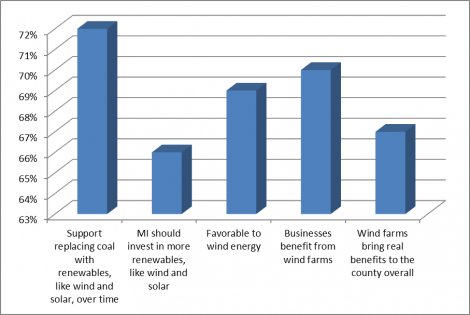Local Michigan Residents Voice Strong Support for Wind in the Thumb
72% Support Replacing Coal with Wind and Solar
Economic
impact of wind development ripples through local economies bringing
new sources of revenue to rural communities
LANSING, Mich., May 9, 2016 — Over the past several months, Wind Works Michigan and 5 Lakes Energy conducted public engagement meetings in Gratiot, Sanilac, and Tuscola counties of Michigan’s Thumb. At each meeting, information was presented on the economic benefits of wind development, its effect on agriculture, how renewables compare to other sources of electric generation, and addressed wind myths with facts. Throughout the meetings, attendees responded to polling questions using hand-held clicker devices.
“The results of these polls have been very positive, with local residents voicing strong support for wind energy in their communities” said Wind on the Wires Executive Director Beth Soholt. “One of the most interesting finding is that 72 percent of those surveyed support replacing Michigan’s coal fleet with renewables like wind and solar; and two-thirds believe Michigan should invest in more renewables as coal plants are retired or taken off-line.”
Poll
shows strong support for wind energy:

New Revenue Sources Help Rural Communities
To date, Michigan has 279 megawatts of wind capacity under construction according to the American Wind Energy Association. “This investment in wind is also an investment in jobs for local communities,” said Skip Pruss with 5 Lakes Energy. “The economic impact of wind development ripples throughout local economies. New tax revenue paid by wind developers brings in millions of dollars every year to help pay for schools; county and township services like roads, police and fire departments; and programs for seniors and veterans. This new source of revenue helps keep more money in the pockets of the citizens.”
Local businesses also see an increase in their business as developers use local service stations, hardware stores, restaurants and hotels in their day-to-day operations. “In fact, one hotel in Huron County reported an 89 percent increase in their revenue as a result of a wind project development in the area,” added Pruss.
“Wind energy provides farmers a new source of reliable, consistent income that helps protect farmland and the future of agriculture here in the Thumb and throughout the state,” said Jim Byrum, president of the Michigan Agri-Business Association.
Keith Iseler, retired Port Hope, Michigan dairy farmer, agrees. “As a farmer, I have figured out that in any area you produce what you can and what you can sell. To produce wind energy, we need adequate wind, a relatively sparse population, and we need a market. We have all of those things in this area.” He added, “The income is stable and the benefits are large. These wind turbine developments can help keep the farmer on the farm.” Wind towers require only about an acre of land, so they do not greatly impact crops or livestock production.
Currently, wind provides 4.19 percent of Michigan’s electricity needs, with 1,531 megawatts of installed capacity from wind. That’s enough to power more than 437,000 homes. The Department of Energy Wind Vision report projects that Michigan could produce enough wind energy by 2030 to power the equivalent of 710,000 American homes. “That’s a lot of potential for further economic development for Michigan at a time when many small, rural communities are struggling to make ends meet and the bulk of their revenue streams are in the hands of state policymakers,” said Pruss.
“Michigan has a lot to gain by investing its energy dollars locally with renewables. Wind developments offer the opportunity to capitalize on jobs and economic development while keeping the air and water clean, and ensuring Michigan’s farm families and rural lifestyle can stay economically viable,” said Soholt.
# # #
Wind on the Wires is a 501(c)(3) nonprofit organization based in St. Paul, Minn., that works to advance renewable energy in the Midwest. Its members are comprised of wind developers, environmental organizations, tribal representatives, public interest groups, clean energy advocates, farm groups and businesses providing goods and services to the wind industry.